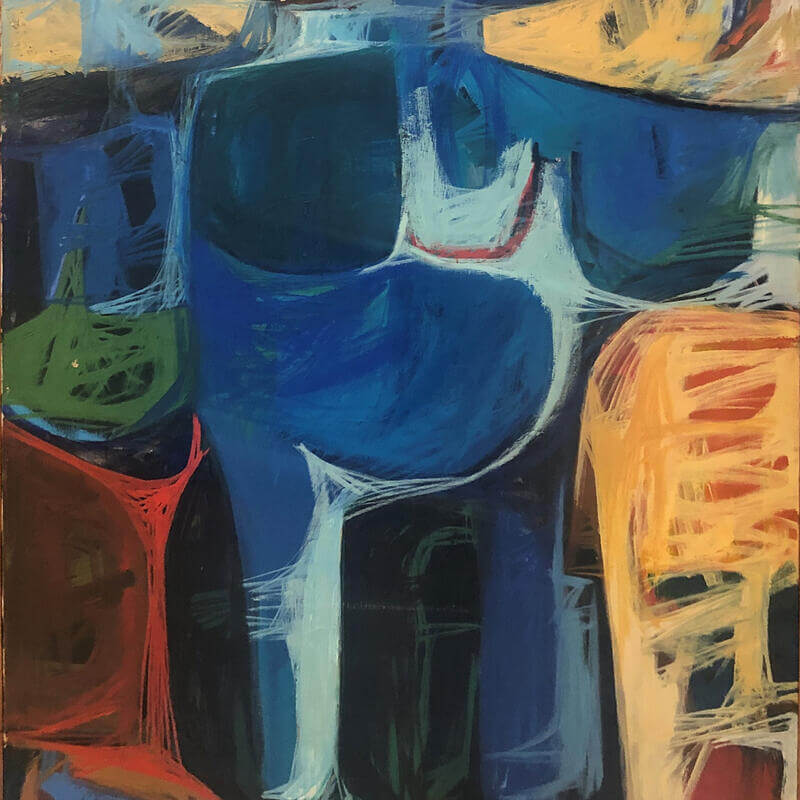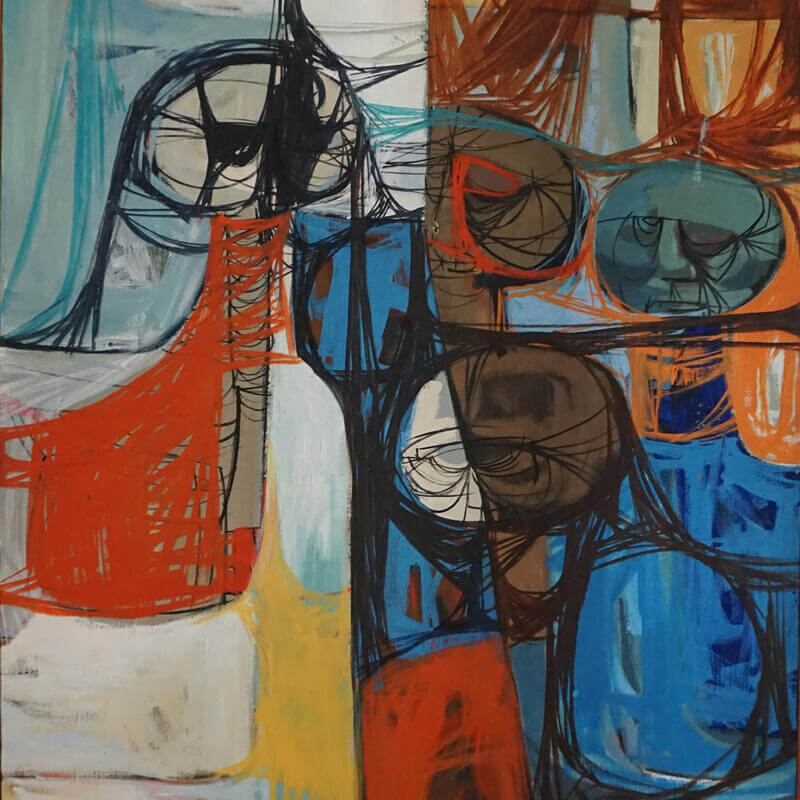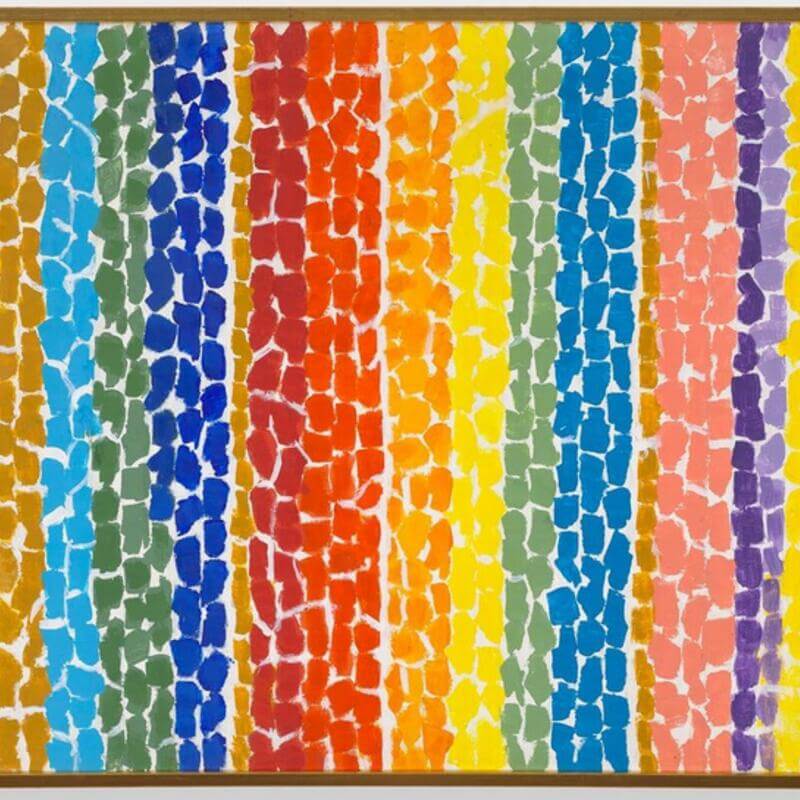James V. Herring Heritage Gallery
Explore a century of Howard University Department of Art alumni in the James V. Herring Heritage Gallery—featuring works by James A. Porter, Alma Thomas, Lloyd McNeill, and more.
Centennial Seal, c. 1967
Graphite and colored pencil on paper
14 x 12 inches
James A. Porter received a Bachelor of Science from Howard University in 1927 and a Master of Arts from New York University, graduating in 1937. He painted many portraits of Howard University luminaries. Porter was the second Chairman of the Department of Art and from 1953 until 1970, the Director of the Gallery.
Best known for portraiture and drafting, Porter also embraced abstraction. He studied in Europe, Africa, and the Americas to learn more about African influences on art in the Black diaspora. His book, Modern Negro Art (1943) was the earliest comprehensive treatment of African American art and remains a classic in its field.
Honored in 1965 with the National Gallery of Art Medal for Distinguished Service to Education in Art, Porter’s art has been exhibited in the Barnett-Aden, Baltimore Museum of Art, Gallery in Washington, D.C., the Detroit Institute of Art and the Museum of Modern Art in New York City. His artwork is included in the Smithsonian Museum of American Art and the Anacostia Community Museum’s collections.
The small centennial seal drawing adorns the 1967 Bison Yearbook in raised gold.
Freedmen’s Hospital School of Nursing, 1961
Oil on canvas
50 x 33 inches
In The Freedmen’s Hospital School of Nursing, Porter honors the Freedmen Hospital tuberculosis nurses. During the 1940s through the late 1950s, the tuberculosis pandemic was prevalent in the African American community. To service its community, Howard University Freedmen’s Hospital built an annex solely to treat tuberculosis in the mid-1950s.
To Our Heroic Brothers, 1949
Oil on canvas
81 x 47 ½ inches
To Our Heroic Brothers is a testament to Porter’s triumph in storytelling. The duplicity of the work honors all World War II veterans, placing the flames above the altar and below distinguished professor Dr. Rayford Logan honors the falling member of the Alpha Phi Alpha fraternity with the laying of a memorial reef.
Dr. Rayford Logan was a World War I veteran and authored Howard University: The First Hundred Years in 1967.
Legend, 1963
Oil on canvas
50 1/2 x 32 inches
Excelsior #9, 1963
Oil on canvas
50 x 30 inches
Lloyd McNeill was a jazz flutist and visual artist born in Washington D.C. McNeill was the first graduate to receive a Master of Fine Art from Howard University in 1963 where he studied printmaking with James Lesesne Wells, easel painting with James A. Porter, watercolor painting with Lois Mailou Jones, and Figure Drawing with Lila Asher.
After graduation, McNeill was appointed to the faculty of Dartmouth College. From 1964 to 1965, McNeill studied lithography at Paris’ L’Ecole Nationale Des Beaux.
He taught at the Mason Gross School of the Arts at Rutgers University in New Jersey where he became a Professor Emeritus. He published two volumes of poems: Blackline: A Collection of Poems, Drawings and Photographs and After the Rain: A Collection of New Poems. In 2007, McNeill was chosen by The United States Postal Service to design a postage stamp for the celebration of the holiday, Kwanzaa in 2009.
The Alvin Ailey ensemble dance piece, Slaves, includes a musical composition by Mr. McNeill. His artwork is at the Smithsonian Museum of American Art collection.
Winona Wing, 1927
Pastel on paper
38 x 32 inches
Self Portrait, 1927
Oil
20 x 23 1/2 inches
Herman Rogers was a gifted draftsman as a student at Howard University, graduating in 1929.
His talents are showcased in his portraits in charcoal, oil, and pastel, including many of which are of himself and his classmates, such as this portrait of Winona Wing.
Self Portrait was reframed through the generous support of the Helen Louise, Effie and Jerry Pettis Endowed Fund.
Man Studying, 1933
Oil on canvas
22 x 30 inches
In Young Man Studying, Hilda Wilkerson Brown exhibits a masterful skill of formal art training in humanizing inanimate objects in the painting. The atmospheric composition captures a young man studying a book while holding a pipe in one hand positioned next to a decorative urn, which balances the painting. For many years, the young academician depicted in the painting was identified as Harlem Renaissance writer Langston Hughes. However, recent scholars have refuted the identification as an assumption of association. Although Brown and Hughes’s families lived in the same community, the writer had left before Brown and her husband Schley Brown moved into the Le Droit Park neighborhood.
Hilda Wilkerson Brown graduated from Howard University in 1932 and continued her education, receiving both a Master of Art and a Master of Fine Arts from Columbia University. Brown was known as a great atmospheric and landscape painter. She painted local scenes of Washington D.C. communities such as her Le Droit Park neighborhood. Brown was an art teacher and public-school administrator. She successfully lobbied to enhance art education for teachers by integrating crafts and the fine and industrial arts. In 1939, Brown illustrated the book The Negro Family in the United States by E. Franklin Frazier.
Orange Glow, 1968
Acrylic on canvas
29 ¾ x 49 inches
Gift of Natalie V. Cole-Johnson
Alma Thomas received a Bachelor of Science in Fine Arts from Howard University in 1924, becoming the first graduate from the Department of Art.
Thomas, along with James Herring and Alonzo Aden founded the Barnett Aden Gallery in 1943, the first Black-owned private gallery in Washington, D.C. A prominent abstract painter of the 1960s and 1970s, Thomas was the first African American woman to have a solo art exhibition at the Whitney Museum of American Art in New York in 1971.
Thomas moved toward abstraction in the 1950s with works like The Stormy Sea (1958), now in the Smithsonian American Art Museum collection. She arrived at her signature style only after retiring in 1960. Spurred by the prospect of a 1966 exhibition at Howard University, Thomas began painting with small daubs of vibrant colors arranged in rhythmic patterns, as depicted here in Orange Glow.
Thomas’ abstractions have been compared with Byzantine mosaics, the Pointillist technique of Georges Seurat, and the paintings of the Washington Color School, yet her work remains uniquely distinctive.
Portrait of Alonso Aden, C. 1930
Pastel and Charcoal
17 x 23 inches
Dan Terry Reid received his Bachelor of Science from Howard University in 1931. As the fourth graduate of the Department of Art, Reid was the only member of the commencement class that year.
Reid continued his studies at the Art Institute of Chicago and the Wicker School of Fine Arts in Detroit, Michigan.
Reid was a prolific and gifted portraitist. He painted portraits of Howard University luminaries such as President Mordecai W. Johnson; Lucy Diggs Slowe, Dean of Women; Benjamin Brawley Griffith, Professor of English; and Gallery of Art Curator, Alonzo Aden, pictured here.
Portrait Study, C. 1943
Charcoal on paper
33 x 23 inches
Doris Houston Brown graduated cum laude with a degree in Fine Arts in 1943 from Howard University. A gifted portraitist, Brown participated and held offices in many campus organizations and activities including President Daubers Art Club. She was also the art editor of the Bison yearbook. Her beauty enabled her to be elected homecoming queen, a member of the Howard Players, and the Alpha Kappa Alpha Sorority, INC.
She left the Washington area after World War II and lived in cities in Europe and the continental United States while accompanying her then-husband, Craig T. Wesley, an Army officer who later retired as a colonel. After settling in New Jersey in the 1960s, Brown worked as an art instructor at a high school and college.
Portrait Study was reframed through the generous support of the Helen Louise, Effie and Jerry Pettis Endowed Fund.
Untitled, c. 1934
Ceramic vessel
6 x 4 in.
The wheel-thrown ceramic urn created by Henry Letcher in 1936 is decorated in Romanesque style. Using a green copper satin matte glaze, Letcher applied a black iron oxide stain to highlight a loggia design. The urn is a classic ceramic fluted design typical of this period.
Henry Letcher was a ceramicist and Tuskegee Airmen. Letcher graduated from the Department of Art in 1934. After graduating, Letcher joined the Army Air Corps as a fighter pilot with the 99th Pursuit Squadron. He furthered his artistic education receiving a Master of Fine Arts from Ohio State University after the war. In his mastery of the medium, Letcher designed a kiln for his thesis.
Letcher dedicated his career to service, teaching briefly at Howard University in the Department of Art before starting an art school for veterans in Washington, D.C., the Letcher Art Center.
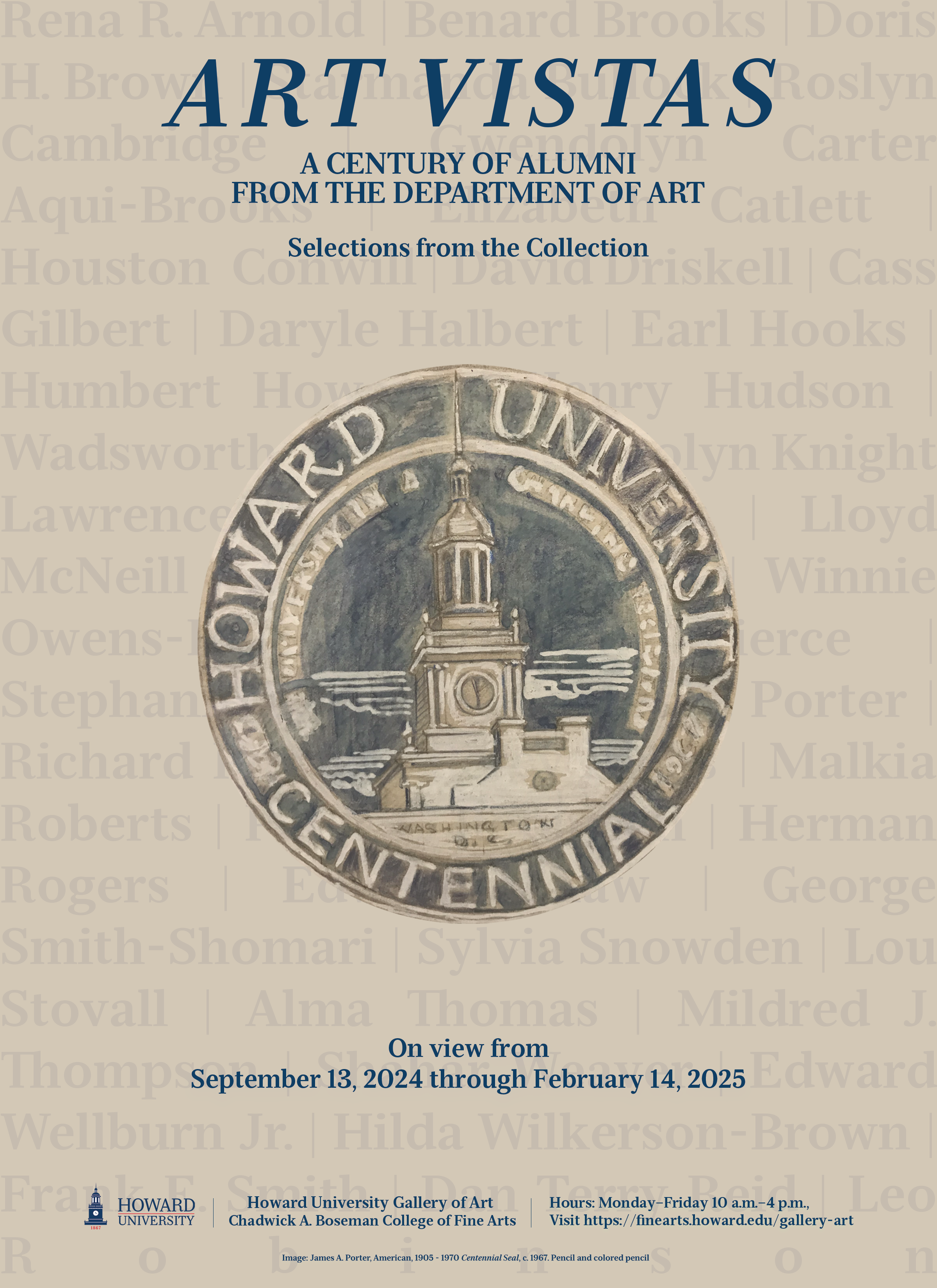
Art Vistas
Visit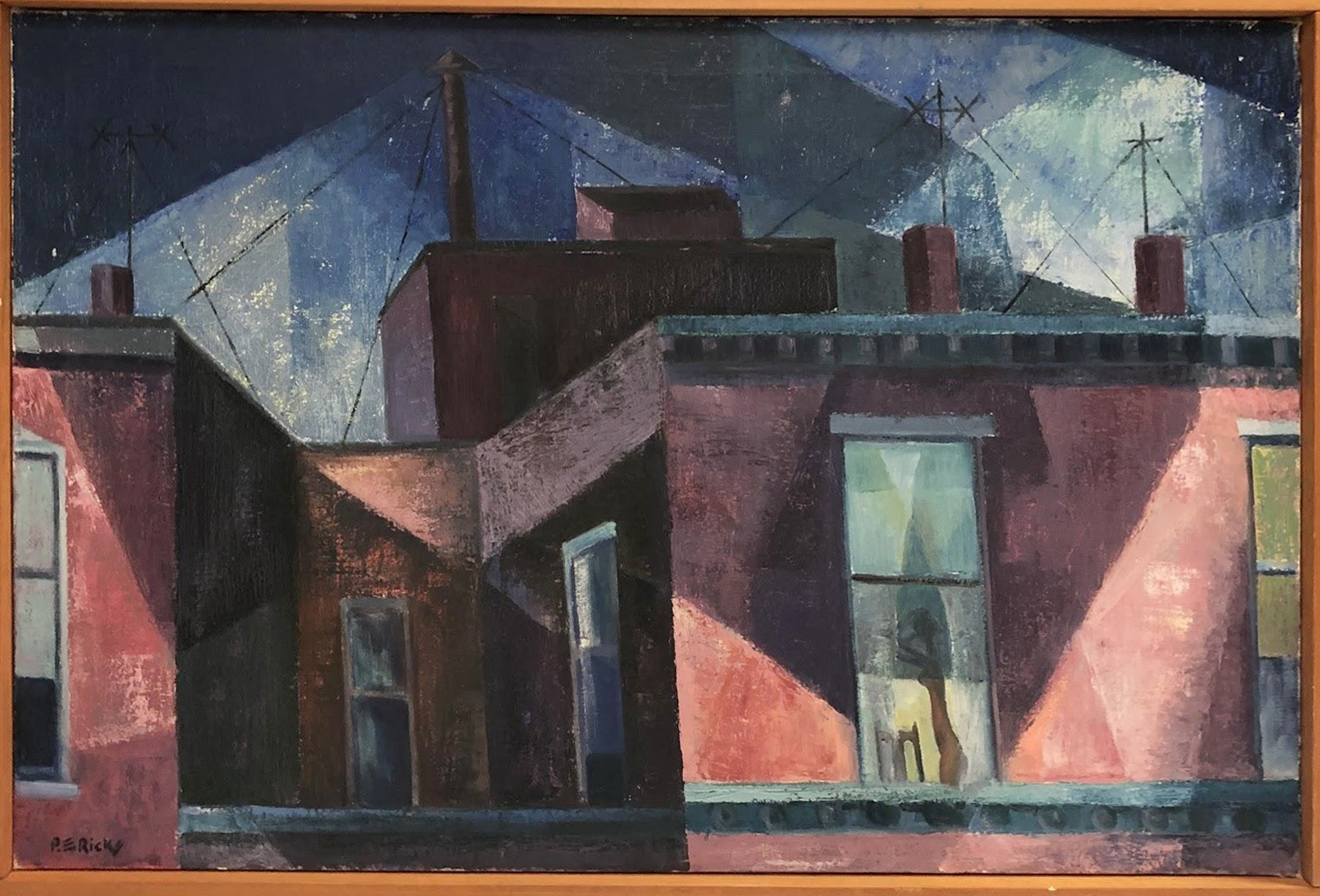
James A. Porter Gallery
Visit

